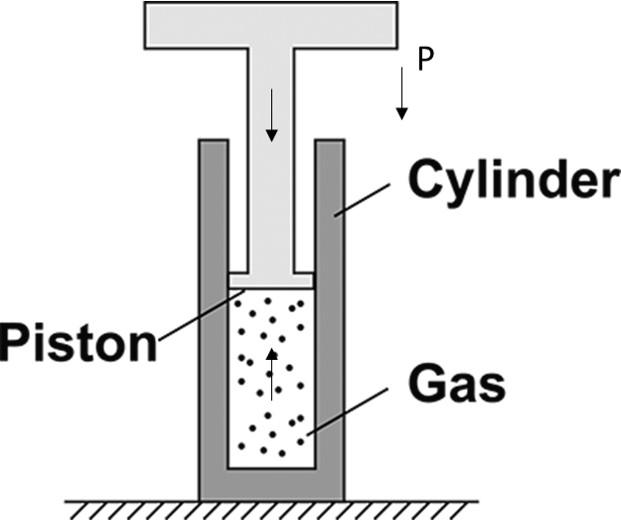
The given apparatus shows a heavy piston supported by gas trapped in a cylinder. The cross-sectional area of the piston is
(Take
A)
B)
C)
D)
Answer
142.2k+ views
1 likes
Hint: In this question, the concept of the pressure is used to calculate the mass of the piston that is pressure is the equal to the applied force per unit area of cross-section of the object and use the force equilibrium equation to obtain the result.
Complete step by step solution:
As we know that the pressure is equal to force per unit area and can be written as,
Where, the applied force is
And we also know that the force is also equal to the weight of the object which is the product of acceleration due to gravity and mass of the object and can be written as,
Here, the mass of the object is

From the above diagram, we can understand, the piston is pushing the gas downwards along with the atmospheric pressure which is also in the downward direction. The pressure applied by the gas is in an upward direction.
Therefore, we can write,
Now, as we know that
Now, we rearrange the above equation as,
Therefore, according to equation (1), when we substitute the value for atmospheric pressure, pressure by gas molecules and force by the piston, we get the following result:
In the question we have given the following quantities,
Substituting the above values in equation (2), we get the following result:
Simplify the above expression we get,
After simplification we get
So, after solving the above equation we get the value of mass of the piston which is
So, the correct option is option (B).
Note: As we know that the pressure applied by the piston and atmosphere is added. It is equal to the pressure applied by the gas molecules inside the cylinder. This is because the piston is not moving and so the force or the pressure is equal from both the sides, that is, above and below the piston.
Complete step by step solution:
As we know that the pressure is equal to force per unit area and can be written as,
Where, the applied force is
And we also know that the force is also equal to the weight of the object which is the product of acceleration due to gravity and mass of the object and can be written as,
Here, the mass of the object is

From the above diagram, we can understand, the piston is pushing the gas downwards along with the atmospheric pressure which is also in the downward direction. The pressure applied by the gas is in an upward direction.
Therefore, we can write,
Now, as we know that
Now, we rearrange the above equation as,
Therefore, according to equation (1), when we substitute the value for atmospheric pressure, pressure by gas molecules and force by the piston, we get the following result:
In the question we have given the following quantities,
Substituting the above values in equation (2), we get the following result:
Simplify the above expression we get,
After simplification we get
So, after solving the above equation we get the value of mass of the piston which is
So, the correct option is option (B).
Note: As we know that the pressure applied by the piston and atmosphere is added. It is equal to the pressure applied by the gas molecules inside the cylinder. This is because the piston is not moving and so the force or the pressure is equal from both the sides, that is, above and below the piston.
Recently Updated Pages
Difference Between Circuit Switching and Packet Switching

Difference Between Mass and Weight

JEE Main Participating Colleges 2024 - A Complete List of Top Colleges

JEE Main Maths Paper Pattern 2025 – Marking, Sections & Tips

Sign up for JEE Main 2025 Live Classes - Vedantu

JEE Main 2025 Helpline Numbers - Center Contact, Phone Number, Address

Trending doubts
JEE Main 2025 Session 2: Application Form (Out), Exam Dates (Released), Eligibility, & More

JEE Main Exam Marking Scheme: Detailed Breakdown of Marks and Negative Marking

JEE Main 2025: Derivation of Equation of Trajectory in Physics

Electric Field Due to Uniformly Charged Ring for JEE Main 2025 - Formula and Derivation

Learn About Angle Of Deviation In Prism: JEE Main Physics 2025

Degree of Dissociation and Its Formula With Solved Example for JEE

Other Pages
Units and Measurements Class 11 Notes: CBSE Physics Chapter 1

JEE Advanced Marks vs Ranks 2025: Understanding Category-wise Qualifying Marks and Previous Year Cut-offs

NCERT Solutions for Class 11 Physics Chapter 1 Units and Measurements

JEE Advanced 2025: Dates, Registration, Syllabus, Eligibility Criteria and More

Motion in a Straight Line Class 11 Notes: CBSE Physics Chapter 2

JEE Advanced Weightage 2025 Chapter-Wise for Physics, Maths and Chemistry




